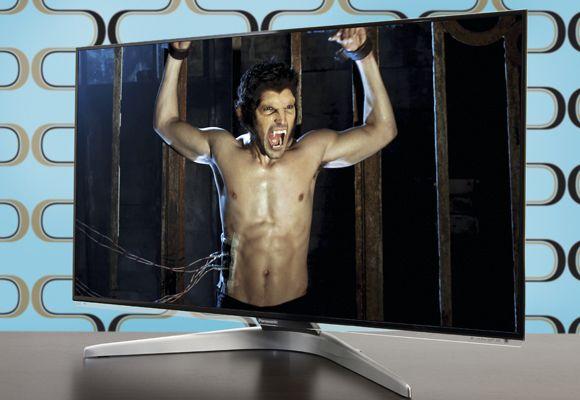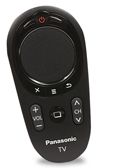Panasonic TX-L42WT50 review

If you’ve been harbouring suspicions that Panasonic is reserving its premium TV technology for plasma, then think again. The brand’s new WT50 line of LED screens oozes proprietary refinement. For those in the market for a leading-edge LCD, Panasonic is determined to be on your shortlist. This is, quite simply put, a barnstormer of a TV.
The WT50 comes in 55-, 47- and 42in screen sizes. We’re focusing on the latter, but all share the same excellent build quality (hats off to Panasonic’s Czech facility), with a super-narrow metal frame, miniscule dark grey bezel and translucent lip with illuminated logo (which you can toggle off, thankfully).
 The set ships with two remote controls – a standard zapper and a funky new Bluetooth touchpad (pictured left). At least it does at retail. My review sample arrived sans touchpad – perhaps Panasonic decided to hide it from me, given how much I’ve disliked the touchpads shipped with its new Blu-ray decks. Can’t say I’m overly disappointed.
The set ships with two remote controls – a standard zapper and a funky new Bluetooth touchpad (pictured left). At least it does at retail. My review sample arrived sans touchpad – perhaps Panasonic decided to hide it from me, given how much I’ve disliked the touchpads shipped with its new Blu-ray decks. Can’t say I’m overly disappointed.
The TV offers both Freeview HD and Freesat HD tuners. One of its three USB inputs (which sit alongside the usual roster of connections) can be assigned to an external hard drive for timeshift recording; you can record to an SD card, too. Given that there’s only a single channel at your disposal, this feature is best thought of as a PVR back-up option.
Alternatively, you can set it to Constant Record, thereby creating a dynamic cache, allowing you to rewind what you’re watching at any point or pause live television broadcasts.
Online all the timeThe TX-L42WT50 comes with a wealth of IPTV and streaming entertainment, courtesy of Panasonic’s Viera Connect internet portal, and its overall ‘net performance is enhanced by a dual-core processor which allows a welcome level of multitasking. You can have, say, iPlayer and YouTube primed and ready to go, even while watching live TV; the live image literally ‘peels’ back should you want to access your apps. It’s really a rather cool embellishment.
Unfortunately, multimedia playback isn’t quite so rewarding. Accessed via the Viera Tools menu bar, the screen manages to play AVI, MP4 and MOV files across a LAN from an NAS but it baulks at MKVs. Things improve with the local USB media reader, which embraces this maverick container.
Other niceties include a radio mode, which automatically dims the display when an audio channel is selected from the EPG, and a web browser that supports HTML5.
The panel itself is a 3D-ready IPS type, with a wider than average viewing angle. As befits a high-end hotshot like this, there are a number of fast refresh technologies at play, leading Panasonic to assign it a 1600Hz backlit scanning badge. This transpires to be quite significant…
Powerhouse performanceThis screen’s hi-def performance is nothing short of exemplary. The panel plates up a tremendous amount of detail from high-definition sources, maintaining texture and tone in a way that’s immediately impressive. Rarely do Freeview HD channels bring out the best in a TV (1080p Blu-ray is nearly always required), but here the WT50 sets a good standard even at tuner level. Indeed, I don’t think I’ve seen any 42in TVs this year which look quite as good with BBC HD as this model.

It’s also more contrasty than a Mod convention. The WT50’s so-called Neo Black LED panel delivers very deep blacks. Indeed, the filter is so extreme I had to set brightness higher than normal just to obtain a comfortable greyscale. The screen also dampens external reflections, which further enhances blacks – yet detail is never lost. The opening alien tease in Gareth Edwards’ Monsters (Blu-ray) maintains its dark, dramatic, nightvision authenticity, yet there’s enough shadow detail to clearly see the creature on the rampage.
The WT50 utilises a new backlight area control technology which divides the screen into 16 portions – this allows it to intelligently control brightness. Backlight uniformity is reasonably good. I never felt distracted by light pooling from the edge LEDs.
For those that want it, there are exhaustive picture parameter controls to tweak, in addition to a fistful of rather decent presets. It doesn’t take very long to settle on an extremely agreeable image.
Motion resolution proves to be a particular strength. Panasonic’s proprietary Intelligent Frame Creation mode has upped its game here, doubtless aided by the intrinsic speed of the panel. Normally, IFC needs to be approached with caution, but here to run without it imposes unnecessary visual penalties. Turned off, the set’s motion detail tumbles below 600 lines, which translates to serious blurring. However, by placing IFC on the Min setting resolution pings back to Full HD. Impressively, this doesn’t introduce any significant artefacts in the process, and horizontal panning is judder-free. The Mid and Max IFC settings do create smudgy artefacts; they also introduce hyper-smooth horizontal panning (the ‘soap opera’ effect). My advice would be to leave IFC on the lower setting.
And what of the TX-L42WT50’s Active Shutter 3D performance? Well, it borders on brilliant. Clarity is exceptional and eyeware brightness compensation effective. However, crosstalk double imaging does rather jump from the screen at inopportune moments to backslap your eyeballs. The menu screen from Tangled (Disney Blu-ray), which features an ever-increasing flood of Chinese lanterns, is quickly awash with ghostly duplicates. Still, I doubt kids will demand a refund.
The TX-L42WT50 supports the new, standardised Bluetooth RF protocol for glasses, with two pairs of spex included in the box. These prove surprisingly light and easy to wear.
Given the shallowness of the set, it still manages to deliver a relatively decent audio performance. There are actually eight drivers crammed into the frame, which create a distinct stereo spread, although the set can’t manage much volume.
ConclusionPanasonic has unleashed a premium screen with poise. HD picture performance is terrific, combining extreme sharpness with a subtle tonality that’s mesmerizing to watch. I even like its 3D implementation – although that tendency to ‘ghost’ is a tad tiresome. Add a rich IPTV selection, slick dual-core multitasking and neat design and you’ve got a TV to be reckoned with.

HCC VERDICT
Panasonic TX-L42WT50
Price: £1,800 Approx
Highs: Excellent HD detail and tonality; good IFC performance; multitasking dual core processor
Lows: 3D suffers from sporadic crosstalk; no support for MKV playback from network attached storage; serious price tag
Performance: 4/5
Design: 5/5
Features: 4/5
Overall: 4/5
Analysis
GUI: Panasonic’s menus remain intuitive and responsive, and the dual-core processor is used to good effect when using the IPTV services
Killer feature: The TX-L42WT50 is the brand’s most ambitious LED yet in terms of design and build. The phrase ‘reassuringly expensive’ springs to mind – this is a set made for a high-end room
Specifications
3D: yes Active Shutter, two pairs of glasses supplied
Full HD: yes 1,920 x 1,080
Tuners: Freeview HD, Freesat HD, CI Slot
Smart TV: yes Viera Connect
Connections: 4 x HDMI; component (via adaptor); Scart (via adaptor); 3 x USB; SD Card slot; Ethernet; D-Sub PC input; digital audio output
Sound: 18W (2 x 4W, 1 x 10W)
Brightness (claimed): N/A
Contrast ratio (claimed): ‘Infinite’
Dimensions (w/o stand): 956 (w) x 569(h) x 27(d)mm
Weight (w/o stand): 11kg
Features: Dual Core processor; integrated Wi-Fi; 1,600Hz Backlight Scanning; SD card/USB HDD timeshifting; USB media playback; DLNA content sharing; HTML5 browser; Dynamic, Normal, Cinema presets; Pro ISFccc 1 & 2 modes; IPS panel; 16-zone intelligent control of edge LED system
 |
Home Cinema Choice #351 is on sale now, featuring: Samsung S95D flagship OLED TV; Ascendo loudspeakers; Pioneer VSA-LX805 AV receiver; UST projector roundup; 2024’s summer movies; Conan 4K; and more
|

















































